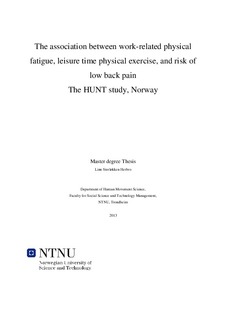| dc.contributor.advisor | Mork, Paul Jarle | nb_NO |
| dc.contributor.advisor | Nilsen, Tom Ivar Lund | nb_NO |
| dc.contributor.advisor | Lier, Ragnhild | nb_NO |
| dc.contributor.author | Herbro, Linn Storløkken | nb_NO |
| dc.date.accessioned | 2014-12-19T14:44:34Z | |
| dc.date.available | 2014-12-19T14:44:34Z | |
| dc.date.created | 2013-08-15 | nb_NO |
| dc.date.issued | 2013 | nb_NO |
| dc.identifier | 640994 | nb_NO |
| dc.identifier.uri | http://hdl.handle.net/11250/271552 | |
| dc.description.abstract | Objectives: It is well documented that high physical work demands is associated with increased risk of chronic low back pain (LBP) while regular physical exercise reduce the risk. However, there is limited knowledge about the combined effect of physical work demands and leisure time physical exercise on risk of LBP. The objective of this study was to investigate whether work-related physical fatigue increases the risk of chronic LBP and if leisure time physical exercise alters this association.
Methods: The study population consisted of 8,293 men and 6,374 women who were vocationally active and who had participated in the Nord-Trøndelag health study in 1984-1986 (HUNT 1) and 1995-1997 (HUNT 2). Risk ratios (RR) of LBP in HUNT 2 associated with work-related physical fatigue and leisure time physical exercise was estimated by a general linear model. Precision of the estimated risk ratios was assessed by 95% confidence intervals (CI).
Results: At follow-up (HUNT 2) 1,267 women and 1,253 men reported chronic LBP. A dose-dependent association was found between work-related physical fatigue and risk of LBP (P-trend <0.001) both among women and men. In specific, women and men who reported to be "often/always" fatigued had multiadjusted RRs of 1.64 (95% confidence interval [95% CI] 1.33-2.03) and, 1.43 (95% CI 1.18-1.74) respectively, compared with those who reported to be "never" fatigued. The different measures of physical exercise showed a weak dose-dependent protective effect on LBP both among women (P-trend <0.16) and men (P-trend <0.14). Analysis of physical exercise showed that women and men who exercised for ≥2 hours per week had a RRs of 0.87 (95% CI 0.70-1.09) and 0.86 (95% CI 0.70-1.04), respectively, referring inactive individuals. Combined analysis showed that individuals who were physically active and reported to be "often/always" fatigued had 30% lower risk (P-value 0.02) than inactive individuals with similar level of work-related physical fatigue.
Conclusion: Work-related physical fatigue is associated with increased risk of chronic LBP in a dose-dependent manner. Leisure time physical exercise can, to some extent, reduce the adverse effect of work-related physical fatigue on risk of chronic LBP. | nb_NO |
| dc.language | eng | nb_NO |
| dc.publisher | Norges teknisk-naturvitenskapelige universitet, Fakultet for samfunnsvitenskap og teknologiledelse, Institutt for bevegelsesvitenskap | nb_NO |
| dc.title | The association between work-related physical fatigue, leisure time physical exercise, and risk of low back pain The HUNT study, Norway | nb_NO |
| dc.type | Master thesis | nb_NO |
| dc.contributor.department | Norges teknisk-naturvitenskapelige universitet, Fakultet for samfunnsvitenskap og teknologiledelse, Institutt for bevegelsesvitenskap | nb_NO |
